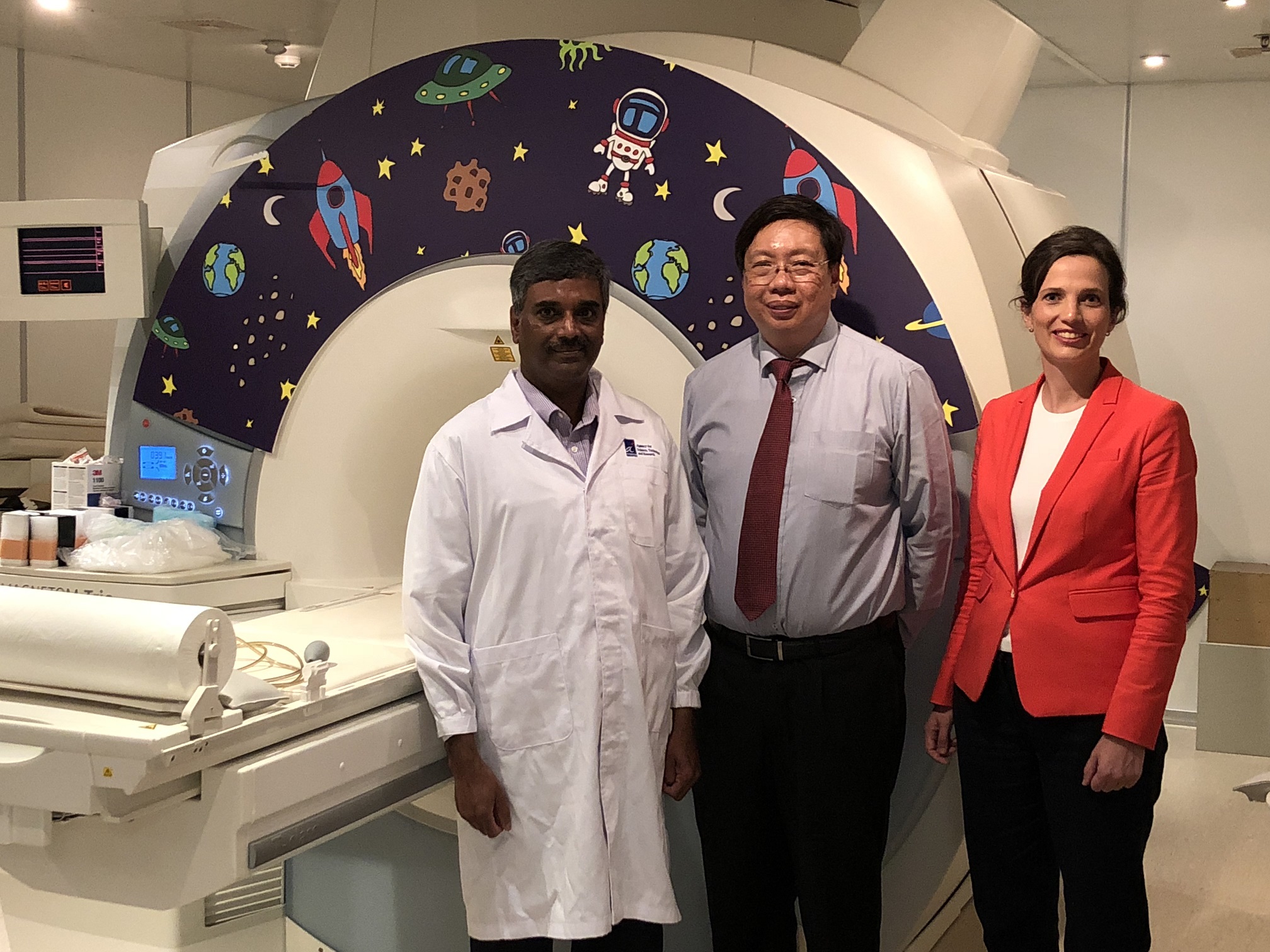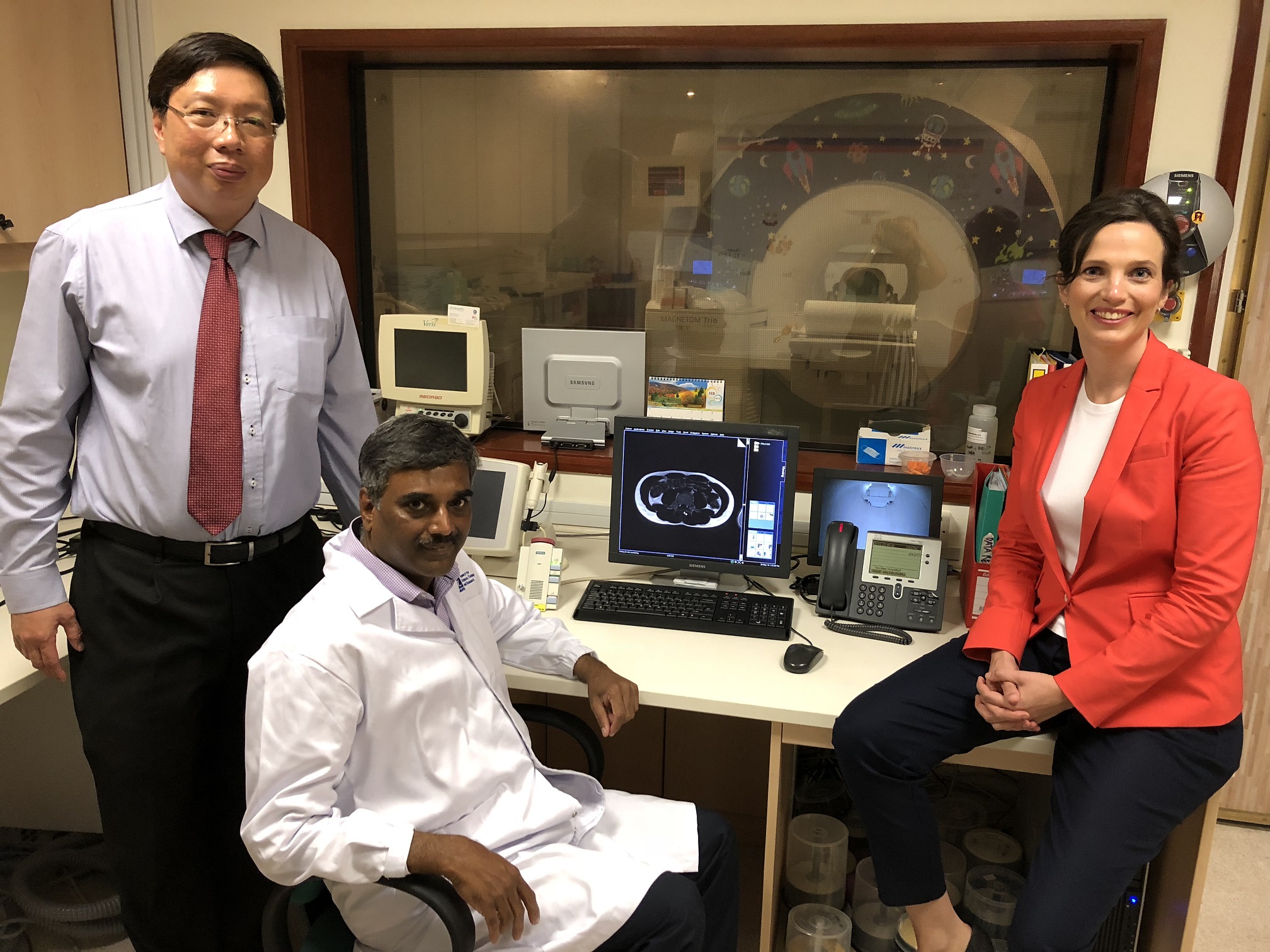A*STAR NEWS
PRESS RELEASES
An Innovative Treatment for Non-Alcoholic Fatty Liver Disease Patients with Diabetes


From left to right: Associate Professor Teoh Yee Leong- CEO of Singapore Clinical Research Institute; Dr. S. Sendhil Velan- Head of Metabolic Imaging Group- A*STAR’s Singapore BioImaging Consortium (SBIC); and Dr Eveline Bruinstroop- Research Fellow- Duke-NUS Medical School
Non-alcoholic fatty liver disease (NAFLD) is a major global health problem characterized by accumulation of fat in the liver. NAFLD develops in patients with obesity- diabetes type 2- dyslipidaemia and insulin resistance. The presence of excess fat in the liver can long be a silent process; however- as the disease progresses the liver will be unable to function normally- which in this stage the damage is non-reversible. Currently- it is estimated that 30-40% of the Singaporeans are affected with no treatment available. Professor Paul M. Yen’s group at Duke-NUS Medical School previously showed that thyroid hormone was important for metabolism of fatty acids in rodent liver and cell culture models. Additionally- they showed that thyroid hormone levels in the liver may be decreased in rats with NAFLD; thus- supplementation with thyroid hormone could be beneficial for patients with NAFLD.
Dr Eveline Bruinstroop and Professor Yen from Duke-NUS Medical School- in collaboration with the Singapore Clinical Research Institute (SCRI)- and Dr. S. Sendhil Velan from the Agency of Science and Technology Research (A*STAR)’s Singapore Bioimaging Consortium (SBIC)- recently completed a clinical study that showed low dose thyroid hormone supplementation may be beneficial for reducing fatty liver in male diabetic patients with NAFLD. The study was funded by Tanoto Initiative for Diabetes Research and the trial and was conducted through the Metabolic Research Network (MRN) of SCRI- and involved six clinical centres across Singapore: Tan Tock Seng Hospital (TTSH)- Singapore General Hospital (SGH)- Ng Teng Feng General Hospital (NTFGH)- Changi General Hospital (CGH)- Khoo Teck Puat Hospital (KTPH)- and National University Hospital (NUH). Dr. Rinkoo Dalan from TTSH was the main clinical investigator of the study.
Twenty NAFLD patients with stable type 2 diabetes and normal thyroid function were treated with thyroxine hormone therapy for 4 months at the particular dosage that was tailored to obtain the desirable TH level individually. Magnetic resonance imaging (MRI) was performed before and after TH treatment to measure the changes in various fat depots including liver fat content. Other clinical measurements such as the control of blood glucose levels were also monitored. Patients that had a larger decrease in intrahepatic lipid content also showed improvements of their diabetes.
Professor Yen- who is from the Cardiovascular and Metabolic Disorders Programme at Duke-NUS Medical School- said- “This is the first clinical study that showed low dose thyroid hormone decreases both liver fat as well as overall body fat in a safe manner in male type 2 diabetic patients with NAFLD. The decrease in liver fat also correlates with an improvement in diabetes control after treatment. This pilot study provides a strong rationale for further investigation- development- and testing of thyroid hormone or thyroid hormone analogues in diabetic patients with NAFLD”.
Associate Professor Teoh Yee Leong- CEO of Singapore Clinical Research Institute- said “This multi-centre trial showcased the capabilities and the strong partnerships of various Singapore research institutions and key clinicians in metabolic disease domain through this research network. This is the first such collaboration- and hopefully there will be more clinical studies that involve the doctors from the six key public sector hospitals in Singapore”.
In this study- SBIC’s Dr S. Sendhil Velan and his team implemented non-invasive magnetic resonance imaging and spectroscopic techniques to quantitatively assess visceral fat- subcutaneous fat and liver fat before and after TH treatment in NAFLD patients. SBIC plans to conduct more studies to evaluate the changes in fat composition within liver fat in response to an intervention.
Dr S. Sendhil Velan- who is head of SBIC’s Metabolic Imaging Group which conducts translational imaging research in the domain of metabolic diseases- said- “Through leveraging our collective expertise and capabilities- we gained valuable insights into the relationship between the thyroid hormone and the metabolism of fatty acids in functional organs. The successful clinical study affirms magnetic resonance imaging and spectroscopic approaches as gold standards for measuring metabolic activity- and these will support future clinical studies in non-alcoholic fatty liver disease- and the development of medical treatments that improve health outcomes”.
About Duke NUS Medical School
The Duke-NUS Medical School (Duke-NUS) was established in 2005 as a strategic collaboration between the Duke University School of Medicine- located in North Carolina- USA- and the National University of Singapore (NUS). Duke-NUS offers a graduate-entry- four-year MD (Doctor of Medicine) training programme based on the unique Duke model of education- with one year dedicated to independent study and research projects of a basic science or clinical nature. Duke-NUS also offers MD/PhD and PhD programmes. Duke-NUS has five Signature Research Programmes: Cancer and Stem Cell Biology- Neuroscience and Behavioural Disorders- Emerging Infectious Diseases- Cardiovascular and Metabolic Disorders- and Health Services and Systems Research. For more information- please visit www.duke-nus.edu.sg
Prof. Yen’s laboratory in the Cardiovascular and Metabolic Disorders Program at Duke-NUS uses molecular biological and genomic approaches to study regulation of transcription- autophagy- and metabolism in the liver by hormones and drugs. They have a strong interest in understanding the pathogenesis of metabolic diseases such as obesity and NAFLD- and developing new and effective therapies for these conditions.
About Singapore Clinical Research Institute
Singapore Clinical Research Institute (SCRI) is a National Academic Research Organisation dedicated to enhance the standards of human clinical research. Its mission is to spearhead and develop core capabilities- infrastructure and scientific leadership for clinical research in Singapore. SCRI is a national clinical trials coordination centre that works with National Medical Research Council (NMRC) to assist the Ministry of Health in implementing clinical trials policy and strategic initiatives to support and develop clinical research competencies locally. In driving towards its vision- SCRI collaborates with clinicians to enhance Singapore’s clinical research and strengthen its expertise in executing multi-site- multi-national studies and the development of regional clinical research networks. SCRI is a wholly-owned subsidiary of MOH Holdings. http://www.scri.edu.sg
About Singapore Bioimaging Consortium (SBIC)
The Singapore Bioimaging Consortium (SBIC) under the Agency for Science- Technology and Research (A*STAR)- is a leading preclinical bioimaging platform in the world. With a multidisciplinary team of biologists- physiologists- chemists- physicists- electrical/electronic engineers- computer scientists- and clinicians- SBIC investigates human diseases which are major public health issues using molecular physiology and advanced bioimaging tools- in a translational and pivotal mode with the medical community and industrial partners. SBIC also works on strategic bioimaging projects- including the development of novel imaging probes.
As a national consortium- SBIC aims to harness existing imaging expertise and capabilities in Singapore- bringing together substantial strengths in the physical sciences and engineering with those in the biomedical and clinical sciences. Through an array of focused collaborations and joint appointments- SBIC fosters and supports the growth of multidisciplinary research activities in the field of bioimaging across local research institutes- universities and hospitals- in order to accelerate the development of biomedical research discoveries. SBIC has a unique capacity to promote rapid transfers of results in animal and human imaging research into the clinical environment- to the immediate benefit of patients. It also ensures the development of financially sound and sustainable contractual research with industrial partners (pharma- food & nutrition- and personal care). SBIC currently operates five joint laboratories with industrial partners under the form of public-private partnerships. For more information about SBIC- please visit www.a-star.edu.sg/sbic.
Was This Article Helpful?
A*STAR celebrates International Women's Day

From groundbreaking discoveries to cutting-edge research, our researchers are empowering the next generation of female science, technology, engineering and mathematics (STEM) leaders.
Get inspired by our #WomeninSTEM
